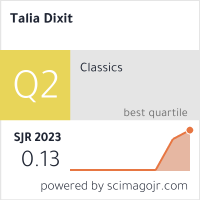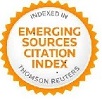Épica, historiografía y retórica: la epipólesis a diferentes naciones en la historiografía grecolatina
Palabras clave:
Historiografía, Poesía épica, Arenga, Epipólesis, Alejandro MagnoResumen
El objetivo del presente trabajo es analizar la evolución de la arenga dirigida a diferentes grupos o naciones según convenga a su carácter o naturaleza. Este tipo de arenga posee una serie de características formales, estructurales y de contenido bien definidas desde Tucídides que se irán repitiendo, con mayor o menor variedad, en todos los casos encontrados a lo largo de la tradición historiográfica grecolatina. En los prolegómenos de la batalla de Iso descrita por Trogo y Curcio, la alocución a diferentes naciones alcanzará su máxima expresión y complejidad quedando incluida en el marco de la epipólesis y siendo encarnada por la figura de Alejandro Magno. Ello nos llevará a buscar su origen y primer modelo en las epipoléseis que se hallan en la Ilíada, con mención especial a la gran Epipólesis de Agamenón del canto IV, y a destacar la fuerte influencia de la retórica en la confección de las descripciones de batalla en las que se insertan tales alocuciones.
Descargas
Referencias
ALLISON, J. W. (1997) “Homeric Allusions at the Close of Thucydides'Sicilian Narrative”, American Journal of Philology 118, 499-516.
ATKINSON, J. E., (1998), Q. Curzio Rufo, Storie di Alessandro MagnoI: Libri 3.-5(a cura di John E. Atkinson; traduzione di V. Antelami), Milán.
AUBRION, E. (1985), Rhétorique et Histoirechez Tacite, Metz : Université Metz.
BARTOLOMÉ GÓMEZ, J. (1995), Los relatos bélicos en la obra de Tito Livio, Vitoria: U. P. V.
BOSWORTH, A. B.(1988),“The Problem of the Speeches”, en From Arrian to Alexander, Oxford: University Press, pp. 94-134.
CARMONA-CENTENO, D. (2005), “Variatio en el discurso exhortativo: la batalla de Zama”, Anuario de Estudios Filológicos 28, 5-19.
____ (2008), La Epipólesis en la historiografía grecolatina, (Tesis doctoral n. p.), Cáceres: Universidad de Extremadura.
FORNARA, C. W. (1983), “The Speech in Greek and Roman Historiography”, en The Nature of History in Ancient Greece and Rome,Berkeley, pp. 142-163.
FOUCHER, A. (2000), Historia proxima poetis. L’influence de la poésie épique sur le style des historiens latins de Salluste à Ammien Marcellin, Bruselas : Latomus.
GIBSON, C. A. (2004), “Learning Greek History in the Ancient Classroom: The Evidence of the Treatises on Progymnasmata”, Classical Philology 99.2, 103-129.
GOMME, A. W. (1937), “The Speeches in Thucydides”, en Essays in Greek History and Literature, Oxford: University Press.
GOMME, A. W., ANDREWS, A., DOVER, K. J. (1945-1981), A Historical Commentary on Thucydides, Vols. I-V, Oxford: University Press.
GRANT, M. (2003), Historiadores de Grecia y Roma (trad. de A. Guzmán Guerra), Madrid: Alianza.
HANSEN, M. H. (1993), “The Battle Exhortation in Ancient Historiography. Fact or Fiction?”, Historia 42, 161-180.
____ (1998), “The Little Grey Horse. Henry V's Speech at Agincourt and the Battle Exhortation in Ancient Historiography”, Histos (1995) (=ClMed 52 (2001) 95-115).
HANSON, V. D. (1991), Hoplites: The Classical Greek Battle Experience, Londres y Nueva York: Routledge.
IGLESIAS ZOIDO, J. C.(2007),“The Battle Exhortation in Ancient Rhetoric”, Rhetorica 25, 141-158.
____ (2009), “The Battle Speeches of Alexander the Great before Issus and Gaugamela” (art. en prensa).
IGLESIAS ZOIDO, J. C. (ed.) (2008), Retórica e Historiografía: el discurso militar en la historiografía desde la Antigüedad hasta el Renacimiento, Madrid: Ediciones Clásicas.
LATEINER, D. (1995), “Nicias’ inadecuate encouragement (Thucydides 7.69.2)”, Classical Philology 80, 201-13.
LONGO, O. (1983), “I discorsi tucididei: uditorio indiviso e scomposizione d’uditorio”, Museum Criticum 8, 139-159.
LÓPEZ EIRE, A. “Retórica e Historiografía en Grecia”, en J. C. Iglesias Zoido (ed.), Retórica e Historiografía: el discurso militar en la historiografía desde la Antigüedad hasta el Renacimiento, Madrid: Ediciones Clásicas, pp. 63-124.
MACKIE, C. J. (1996), “Homer and Thucydides: Corcyra and Sicily”, Classical Quarterly 46, 103-13.
MARINCOLA, J. (1997), Authority and Tradition in Ancient Historiography, Cambridge: University Press.
____ (2007), “Speeches in Classical Historiography”, en J. Marincola (ed.), A Companion to Greek and Roman Historiography, Londres y Nueva York: Blackwell, pp. 118-32.
MOMIGLIANO, A. (1981), “The Rhetoric of History and the History of Rhetoric: On White’s Tropes”, en E. S. Shaffer (ed.), Comparative Criticism, vol. III, Cambridge: University Press, pp. 254-68.
____(1990), The Classical Foundations of Modern Historiography, Berkeley y Los Angeles: University of California Press.
NICOLAI, R. (1992), La storiografia nell’educazione antica, Pisa: Giardini.
____ (1999) “Polibio interprete di Tucidide: la teoria dei discorsi”, Seminari Romani di Cultura Greca 11, 280-301.
____(2002), “Unam ex tam multis orationem perscribere: riflessioni sui discorsi nelle monografie di Sallustio”, Atti del primo convegno nazionale sallustiano, L'Aquila 28-29 settembre, L'Aquila : Centro di Studi Sallustiani, pp. 43-67.
____ (2007), “The Place of History in the Ancient World”, en J. Marincola (ed.), A Companion to Greek and Roman Historiography, Londres y Nueva York: Blackwell, pp. 13-26.
ONIGA, R. (2003),Tacito. Opera omnia (2 vols.), Turín: Einaudi.
PORCIANI, L. (2004), “Lo storico nel mondo antico: storia e retorica”, en M. Betalli (ed.), Introduzione alla storiografia greca, Roma: Carocci, pp. 21-36.
PRITCHETT,W. K. (1974), The Greek State at War, vol. II, Berkeley y Los Ángeles: University of California Press.
____(1985), The Greek State at War, vol. IV, Berkeley y Los Ángeles: University of California Press.
____(1994), “The General’s Exhortations in Greek Warfare”, en Essays in Greek History, Amsterdam: Giessen, pp. 27-109.
____(2002), Ancient Greek Battle Speeches and a Palfrey, Amsterdam: Giessen.
ROMILLY, J. DE (1967), Histoire et raison chez Thucydides, París : Belles Lettres
SANCHO ROYO, A. (1988), “Retórica e historiografía en la época helenístico-imperial”, en M. Brioso y F. J. González Ponce (eds.), Actitudes literarias en la Grecia Romana, Sevilla: Universidad, pp. 295-318.
STRASBURGER, H. (1972), Homer und die Geschictsschreibung, Heidelberg.
VRETSKA, K. (1976), De Catilinae Coniuratione (2 vols.), Heidelberg.
WALBANK, F. W. (1965), Speeches in Greek Historians, Third J. L. Myres Memorial Lecture, Oxford (= WALBANK (1985), “Speeches in Greek Historians”, Selected Papers. Studies in Greek and Roman History and Historiography, Cambridge: University Press, pp. 242-261).
WHEELER, E. (1991), “The General as Hoplite”, en V. D. Hanson (ed.), Hoplites. The Classical Greek Battle Experience, Londres y Nueva York: Routledge, pp. 121-170.
WHITE, H. (1973), Metahistory: The historical Imagination in Nineteenth-Century Europe, Baltimore y Londres: Johns Hopkins University Press.
____(1987), The Content of the Form: Narrative Discourse and Historical Representation, Baltimore y Londres: Johns Hopkins University Press.
WISEMAN, T. P. (1979), Clio’s Cosmetics: Three Studies in Greco-Roman Literature, Leicester: The University Press.
____(1993),“Lying Historians: Seven Types of Mendacity”, en Ch. Gill y T. P. Wiseman (eds.), Lies and Fiction in the Ancient World, Exeter y Austin: University of Texas Press, pp. 122-46.
WOODMAN, A. J. (1988), Rhetoric in Classical Historiography, Sidney y Londres: Croom Helm.












